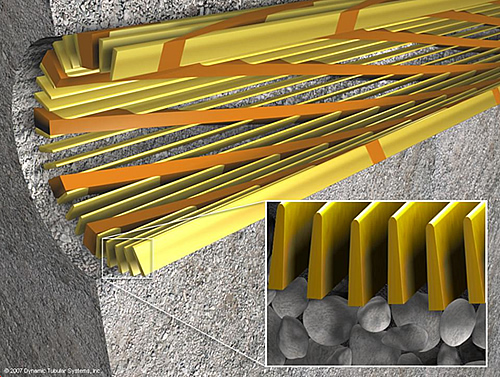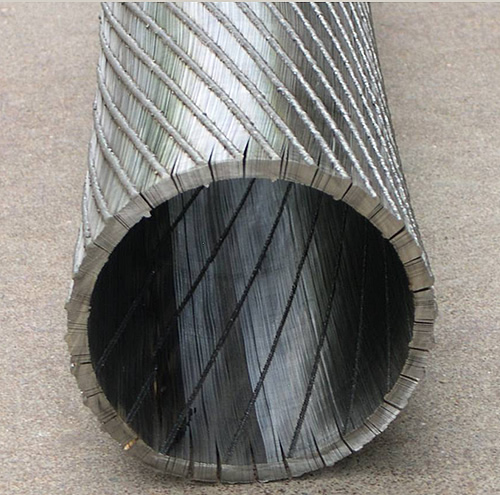Small-diameter well bores pose unique completion and production problems. Their higher fluid velocities facilitate sand movement, plugging, and erosion mechanisms. Use of gravel-packs in microholes is constrained by limited annular volumes. Placing excessively thick sandscreens restricts production and creates difficulties against passage of other completion and well-servicing equipment, including pumps, sleeves, packers, geophysical tools, etc.
The project aims to develop production tubulars that cover all market demands by developing a new ability to screen all sand particle sizes; by offering high-hydraulic efficiencies; by showing the feasibility of higher-strength, wear-resistant alloys; and by reducing obstructions to flow, regardless of the production environment.
Results
The project has proven concepts for innovative sandscreens that solve critical mechanical strength and performance issues in the conventional expandables industry. The project resulted in the development the first expandable sandscreen capable of retaining all downhole particle retention requirements; improvement of flow efficiencies in order to increase production; and, created products that minimize field costs while functioning well in narrow microhole clearances. Because the technology can be manufactured from any type of material, it will mitigate problems caused by high-pressure losses and any erosion potential for all types of micro-well production.
Benefits
Use of simplified, higher-flow sandscreens result in more thorough well cleanup and reduced costs due to fewer needed well interventions. Because the new screen is designed to be plug- and erosion-resistant, fewer well shutdowns and greater overall production will also result from use. The new sandscreen is also expected to be lighter and less expensive.
Results
The novel sandscreen design shows simultaneous solutions to all conventional expandable-screen problems, including low-collapse strength and issues relating to voids caused by low formation-compliance rates. Rigorously engineered collapse properties show >4000-psi capability, some 2X-15X higher than conventional ratings. Formation contact properties of the technology also exerts elastic energy against the well which increases stability and production long-term. This sought-after flexible support property of modern rock mechanics theory is virtually non-existent conventionally. Measured results show the technology’s flexible support properties to be minimally 400% over the highest preferred specifications requested by major energy producers.
Summary
The sandscreen technology developed is a highly supported, grid-type construction of close-tolerance, slotted panels that can also be tuned to provide detailed control over well hydraulics and particle filtration. These panel elements are ideally recessed from the OD, creating greater flow-area towards the producing formation. Construction is flush about the ID, allowing smooth surfaces for other downhole operations. Tubular strength results from large strain-substructures acting as a robust mechanical system.
The first project phase developed the sandscreen concept into a refined design model through design-by-analysis protocol. Novel performance specifications were created to serve as the design basis. This specifications development included accumulation of the minor amounts of information available conventionally and obtaining additional input from major producers.
The analytical design processes resulted in a rigorous nonlinear, 3-D computational model demonstrating completely novel mechanical properties for expandable sandscreens. These properties are in excess of the project’s proposed goals and are well in excess of the highest industry standards. The properties, relating to collapse strength and resilient geological compliance, are many orders-of-magnitude improvements over the best individual properties of conventional service company capabilities. The achievements are also orders in excess of the ideal specifications provided by major producers. A further advance showed the proposed prototype self-expanding sandscreen configuration, as predicted by nonlinear finite-element analysis, to be fully elastic in all regions of operation, providing significant recovery of strain energy during expansion.
A fully detailed, 3-D field prototype design model was completed, based on lower-to-middle ranges of the overall proficient modeling results.
The first achievement of the advanced engineering phase was an improved sandscreen-to-formation compliance scheme. Through this project, the state of the art in flexural support by expandables now consists of a tunable, complete 3-D nonlinear beam element model of a short-section, mechanically proficient sandscreen that is self-expanding against elliptical wellbores. Auxiliary mechanical capabilities in the design system provide for structural integrity in difficult wellbore conditions.
A screen filter test with a 45% producing open area was fabricated. The sample was used in a standard laboratory sand-slurry efficacy test. Successful operations were conducted for particle retention, screen plugging resistance, and hydraulic pressure loss characteristics. The results showed commercially acceptable retention levels of a correctly sized sand in excess of 99%. The plug-resistance capabilities displayed a significant portion of the producing area as completely unaffected by the test solids, and pressure loss throughout the process never exceeded 8% of the test system’s rating.
The manufacturing developments lead to discoveries in fabrication processes that underpin the feasibility of constructing the sandscreen technology from essentially any type of alloy—including standard steels, advanced alloys, tool steels, and even tungsten alloy materials. If this feasibility is further confirmed, this achievement will substantially enhance the already proficient properties under development and will create novel applications for expandables and benefit numerous other facets of producing resources from wells of all types.
Physical testing of prototypes showed properties well-above the high values predicted by theoretical analysis.
A successful field demonstration was performed as scheduled. The demonstration took place as a monobore deployment by expanding a prototype below contractor’s previously set, related technology – also a NETL project.





